Gerd-Rüdiger Lang’s 850-Piece Chronograph Collection: Likely The Most Complete Collection Of Wrist Timers In The World
Many of you are likely to be asking yourselves, “Who is Gerd-Rüdiger Lang?”
Understandable.
If I told you he founded Chronoswiss in 1983 you might then say, “Ah, yes.”
But did you know that Lang, who sold Chronoswiss in 2012, owns a collection of chronographs that might well be the most complete themed collection of this type in the world?
To understand it, let’s first find out more about this man’s history and why he has collected these timers for 50 years.
Who is Gerd-Rüdiger Lang?
Lang was born in 1943 in Braunschweig, Germany, in a non-watchmaking family and environment. Like many other talented figures in the colorful watch industry, he “fell” into watchmaking in a common way of the previous generation: by being a lousy student with the need to learn a trade. And his father prompted him to go into watchmaking because he deemed it a profession with a real future.
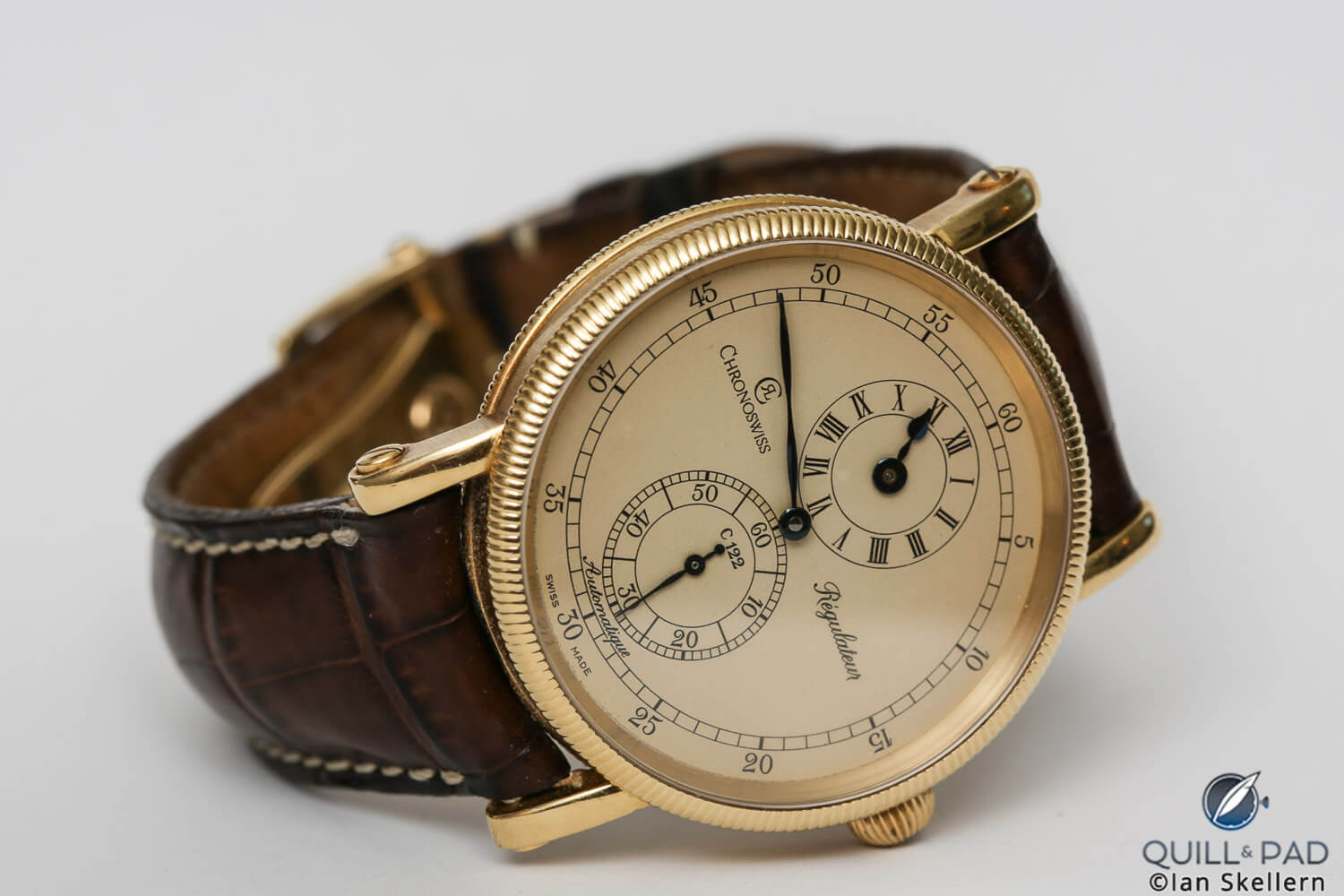
The quintessential Chronoswiss model and the first of its kind: this Régulateur is Gerd-Rüdiger Lang’s own daily wearer
At the age of 19, his apprenticeship behind him, he remained in the shop to work with watchmaker Günter Jauns. After that he spent one and a half years at a rural watchmaker’s shop on Fehmarn, an island off the northeast coast of his native Germany.
But the time came when this young man realized that if he really wanted to seriously work with watches he would need to go to Switzerland, where the pulse of the watch industry beat.
At first Lang worked for six months at Hamilton, but in 1964 he went to Heuer, a large company with about 160 employees led by Charles Heuer, Jack Heuer’s father. Jack only returned to Biel a year after Lang began working there as he had been in the United States building a subsidiary.
Lang first worked in the production of stopwatches – Heuer’s primary business at the time – but later learned to assemble chronographs the traditional way. Chronographs made up about 10 percent of Heuer’s turnover at that time.
In 1968 he was sent to the German branch in Frankfurt, where he remained until 1974 when he went to Munich, the new home of the Heuer subsidiary, Heuer Time GmbH, to direct the technical department, which included customer service.
In addition, Lang was active in sports timekeeping at international events such as the German Formula 1 races, where he was the timekeeper. He even attended the 1980 Olympic Games in Moscow for Heuer in the service of official timekeeping.
Between 1978 and 1982 the world of European watchmaking was in crisis. When Lang was 37 years old in 1980, Jack Heuer came to the Munich workshop to close down the subsidiary. This was a familiar story in that time period, and only the truly innovative and self-confident survived the era.
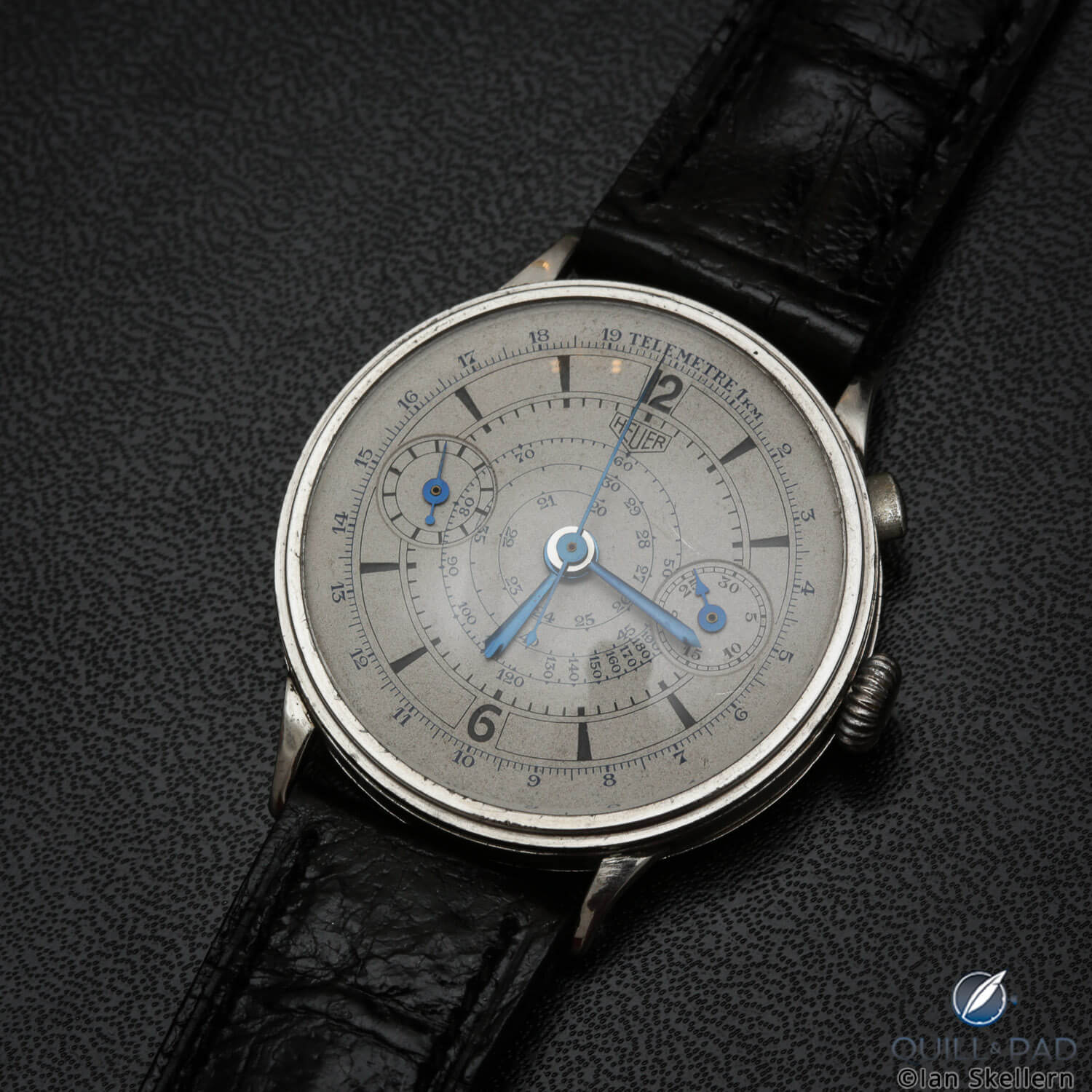
A Heuer wrist chronograph from Gerd-Rüdiger Lang’s extensive collection
Lang opened a self-employed service center for Heuer watches right on his kitchen table. Whether that was self-confidence or another emotion is hard to say. Either way, it was the right decision as hindsight shows.
Chronoswiss arose from this period in Lang’s life. He had bought some movements from Alfred Rochat in the Vallée de Joux, encased them in a classic design, and sold them in his small shop – at first with Rochat’s name on the dial, and a year later with the brand name Chronoswiss added, a moniker he had invented and finally registered in 1983.
Inventor of the modern display back
Then he had the ingenious idea of putting a transparent pane on the back of the case to show people the beautiful inside of the object they were buying. He was the first to do this in the modern era.
This master watchmaker poured all his heart and soul into the making of Chronoswiss, incorporating his attitude of traditional and lasting values and believing in the mechanical watch when almost no one else did. And his watches reflected this hang toward perfectionism, idealism, and everlasting love of his traditional craft.
It was the height of the so-called quartz crisis, and the mechanical watch was all but dead. Or so they said.
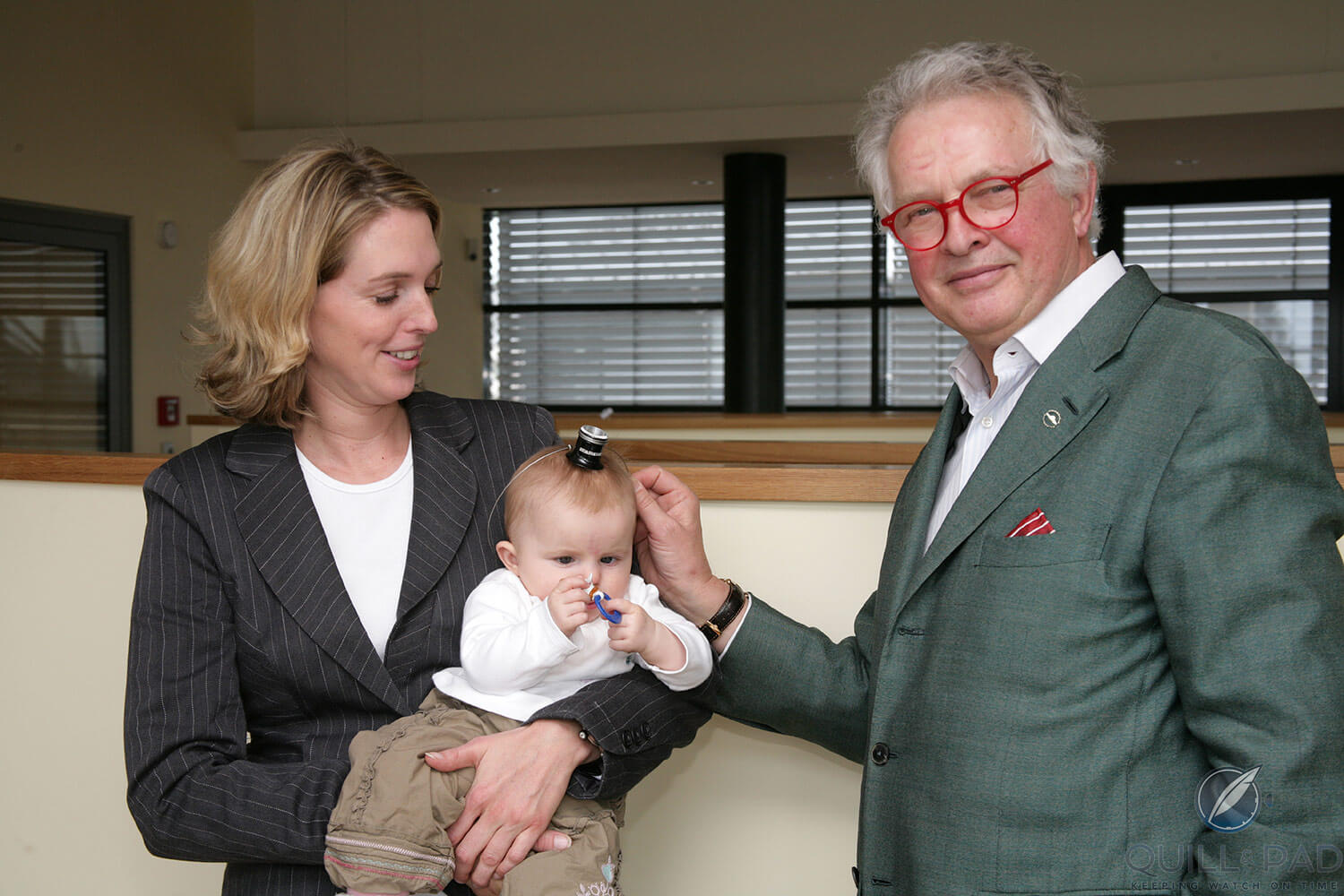
Gerd-Rüdiger Lang with daughter Natalie (also a watchmaker) and grandchild at the now-defunct Munich factory in 2007
Gerd-Rüdiger Lang chronograph collection history
Lang’s love of chronographs blossomed during his time at Heuer, one of the most important chronograph makers of the 1960s; it was there that he experienced the birth of the automatic chronograph firsthand as Heuer pitted its Caliber 11 against Zenith’s El Primero and – unknowingly – Seiko’s Caliber 6139. An example of each of these three chronographs is of course represented in his extensive collection.
By 1980, when he was forced into becoming self-employed, Lang had already started collecting vintage timepieces – mainly chronographs – and had begun to see watches from a different perspective: not just as the product from which he earned his living, but as a legacy.
“The mechanical watch is the most precise, most exact machine that mankind has ever created, with a deviation of just fractions of seconds per day,” he explained to me years ago during a visit to his Munich factory.
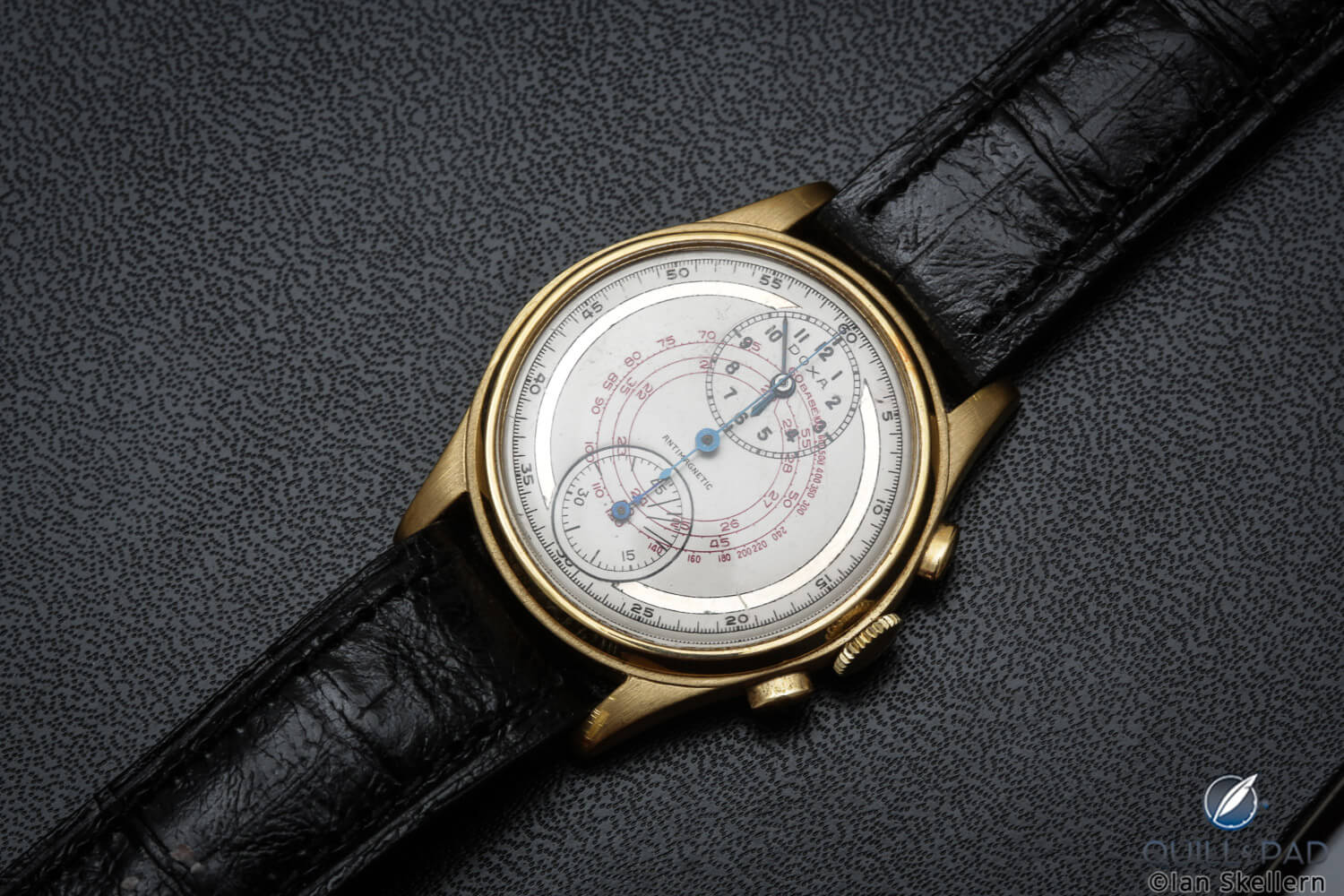
This 34 mm gold-plated Doxa chronograph powered by Venus Caliber 140 is part of Gerd-Rüdiger Lang’s extensive chronograph collection
“Every week. Every month. For one year, two years, three years. Then an overhaul and it has its precision back. An automobile, a coffeemaker, an electric razor – these machines can’t hold a candle to a watch. An automobile is driven for two hours, then it gets put in the garage. Imagine what would happen if you had to drive a car for four years in a row at top speed. Impossible!”
Lang’s vintage chronograph collection is likely the world’s best and most complete of its kind. “Most people who collect something go according to the beauty of the object,” he explained. “I have always had a different approach, first looking at the other side to see if the watch is in good mechanical shape. You cannot make a bad watch good. It just doesn’t work.”
In fact, it was so complete that when Lang’s previous employer Heuer (now TAG Heuer) began searching out chronographs from the brand’s past, the first place they came looking was Lang’s collection – and he actually had enough to spare, generously providing Heuer with a number of his timepieces for the brand’s own museum.
Already at that time, Lang occupied himself with chronographs above and beyond professional interest: their history, diverse versions and designs, and the maintenance of his sizable collection had turned him into a true expert.
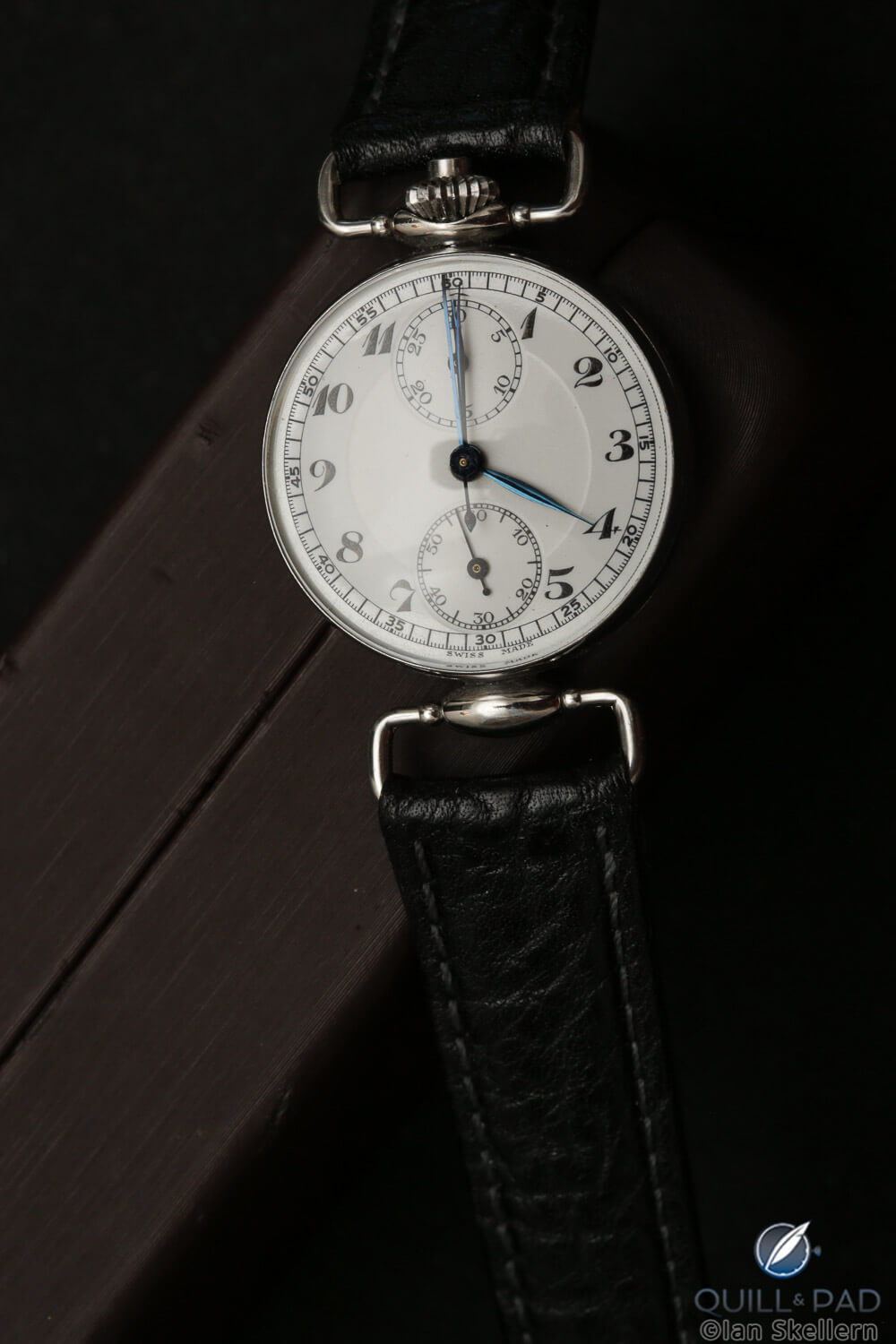
A Pontifa chronograph from about 1935 with vertical clutch from Gerd-Rüdiger Lang’s extensive chronograph collection
There are only a few people in Germany – and indeed likely anywhere – whose expert knowledge in the field of chronographs can be measured with Lang’s. Recognized for this skill, Lang co-authored the book Chronograph Wristwatches: To Stop Time along with watch historian Reinhard Meis. This book remains a standard reference in the field.
And it was not only Lang’s background at Heuer that got him interested in timing, it was also his raging passion for vintage automobiles, Jaguar in particular.
Gerd-Rüdiger Lang’s own words on the collection
I have spoken to Lang many times about this collection over the approximate 30 years I have known him. In Chronoswiss’ purpose-built factory in Karlsfeld, just outside Munich, units from the 850-piece collection were even on display in specially designed little windows scattered throughout the building.
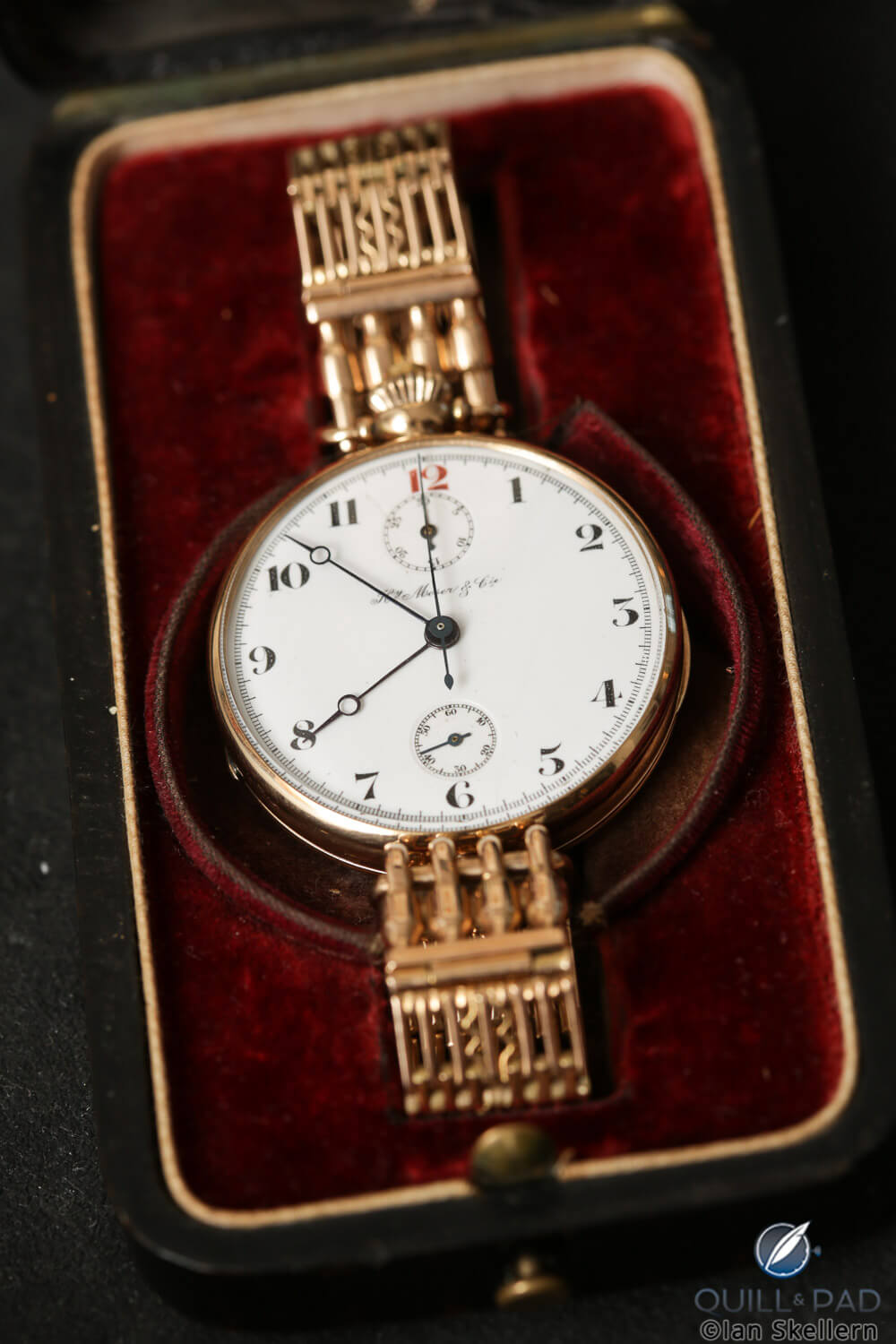
Henry Moser wrist chronograph with gold Fabergé bracelet from the early 1900s from Gerd-Rüdiger Lang’s extensive chronograph collection
“Most of my modern Chronoswiss collection is rooted right here in my vintage watch collection,” he explained to me during a visit to that factory shortly after it opened, illustrating the point with a watch made by Henry Moser from the early 1900s. That particular specimen sporting a gold bracelet crafted by Fabergé’s workshop was sold in Russia.
But those were not the attributes that caught Lang’s eye: pointing out the enameled dial with its red 12, he asked, “Have you ever seen my Orea? Now you know where the inspiration for it came from.”
And a very large pilot’s watch from 1942 powered by a vintage Minerva caliber looked strikingly similar to Lang’s Timemaster, a watch that was wildly successful for his Chronoswiss brand.
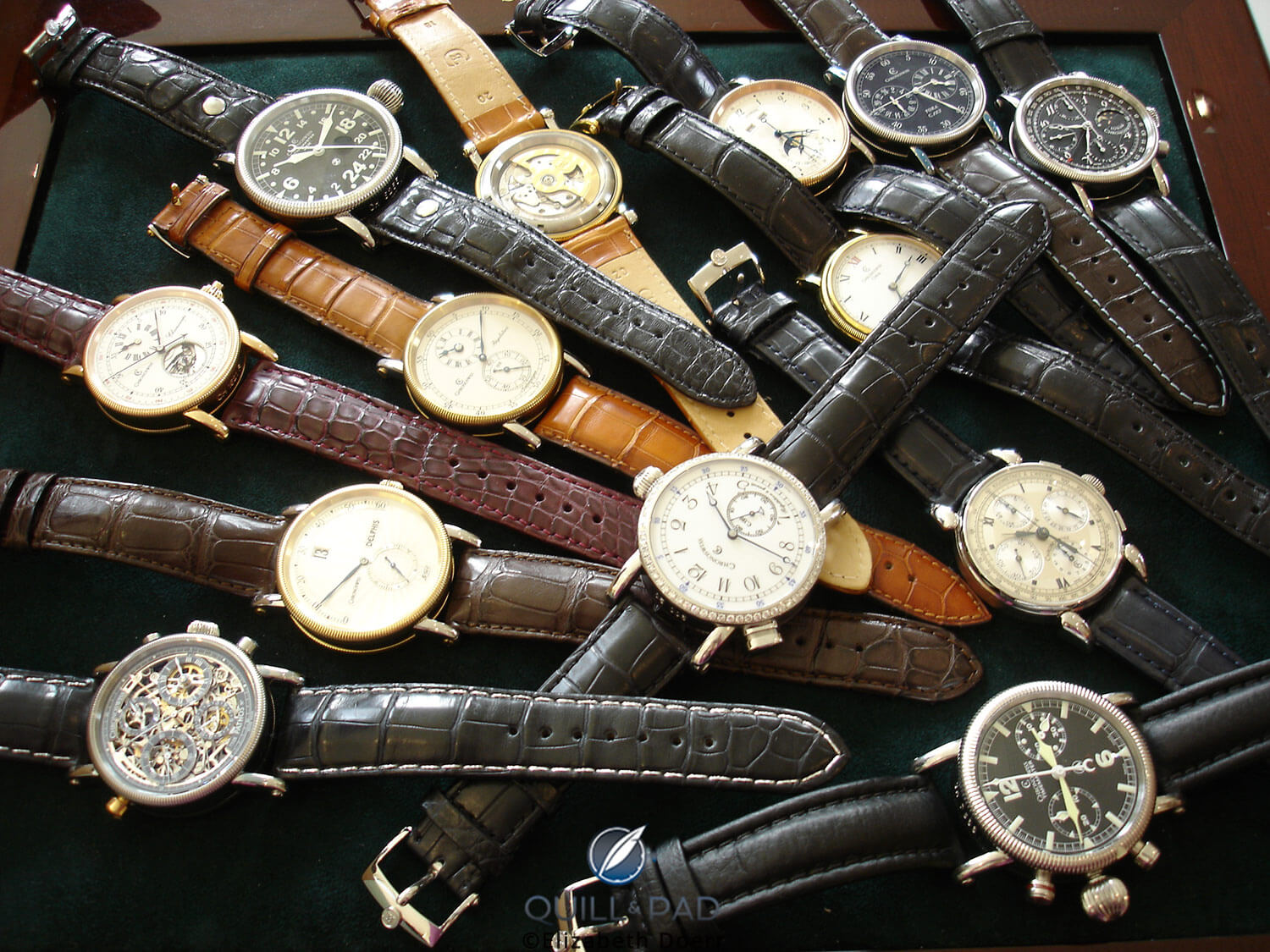
A group of Chronoswiss watches with the Timemaster in the lower right corner and the Régalateur and Orea in the center
“I have many favorites in my collection, which is actually a themed collection of chronographs with various designs and functions,” he went on. “Some are very cheap, while others are much more expensive. Then there are some that are just perfect, perfect meaning that the movement, the shape of the case, the hands – just everything – fit together perfectly. Those are my favorite pieces, the unusual ones that set off trends – like the Monaco by Heuer.”
Unfortunately, the Chronoswiss Munich factory no longer exists and the collection is no longer on exhibit anywhere. But I feel very fortunate to have seen a few of its highlights again recently.
“I collected this group of chronographs over 50 years,” Lang told me in late fall 2017 as we enjoyed the view from his balcony at Lake Starnberg just outside Munich. “And this collection has always had just one focus: chronographs.”
And he explained in a bit more detail the gist of his collection. “Everyone knows how to collect Patek Philippe, for example. But how to collect a specific collection based on a technology is something else. I wanted to have different movements, be able to show the great depth of various chronographic ideas.”
A chronograph mechanism adds 60 to 80 separate components to a movement, and these must all work precisely together to reach the common goal of timing an event.
“And such a collection has to have a personal character to be able to explain it to other people,” he added.
A sampling of chronographs in Gerd-Rüdiger Lang’s collection
Back in 2001, Lang named one of his most famous Chronoswiss chronographs the Chronoscope, rooted in the Greek word chronos (time). Since one can only see how much time has gone by since the stop mechanism was activated on the watch – as is the case with all chronographs whose hands show an interval of time but don’t document it – the Chronoswiss founder completed his “time word” with a variation of the Greek skopein, meaning “to see.”
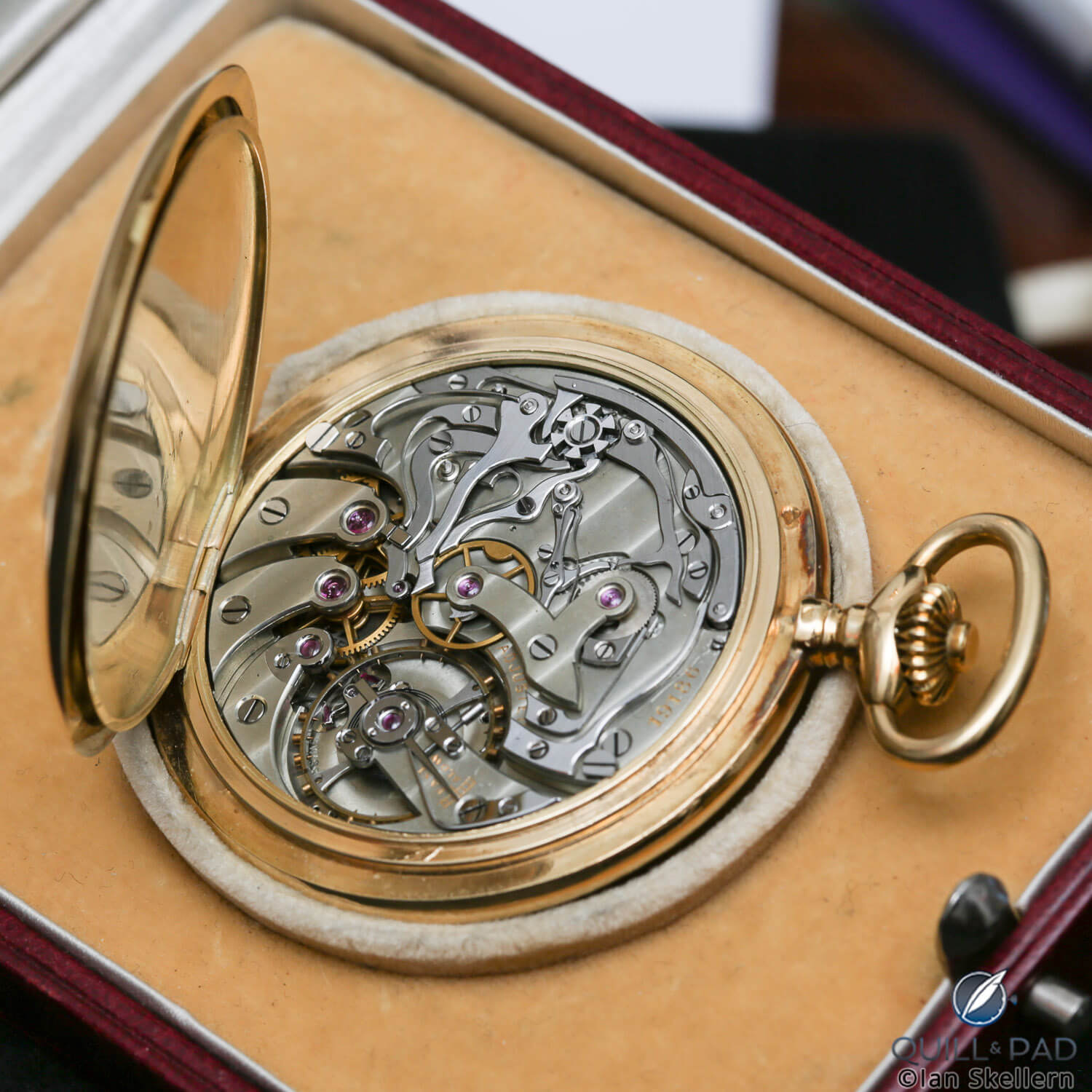
The movement of a Poitevin-LeJeune pocket watch chronograph from Gerd-Rüdiger Lang’s chronograph collection
A compromise to the international success of the Munich-based watch house caused the k from skopein to become a c, and the new watch name was born.
This anecdote goes to illustrate how much thought Lang always put into chronographs – both in his personal collection and in his former brand’s collection.
Lang’s collection encompasses what I would call the entire developmental history of the chronograph (except for Louis Moinet’s Compteur de Tierces, of course; considered the very first chronograph, it is now in the possession of Louis Moinet). This includes early ink-drop chronographs, stopwatches, and wrist chronographs that range from simple pin-pallet pieces to some of the finest examples made in France, England, and Switzerland.
The collection, which also includes curiosities and branded as well as non-branded timepieces, spans approximately the years 1820 through 2000.
Matthias Wolfensberger unique piece pocket watch from Gerd-Rüdiger Lang’s chronograph collection
The unusual and unique pocket watch by Matthias Wolfensberg seems to be Lang’s favorite piece in the collection, despite the fact that even dyed-in-the wool watch fans have very likely never heard of this German watchmaker who made his home in Switzerland.
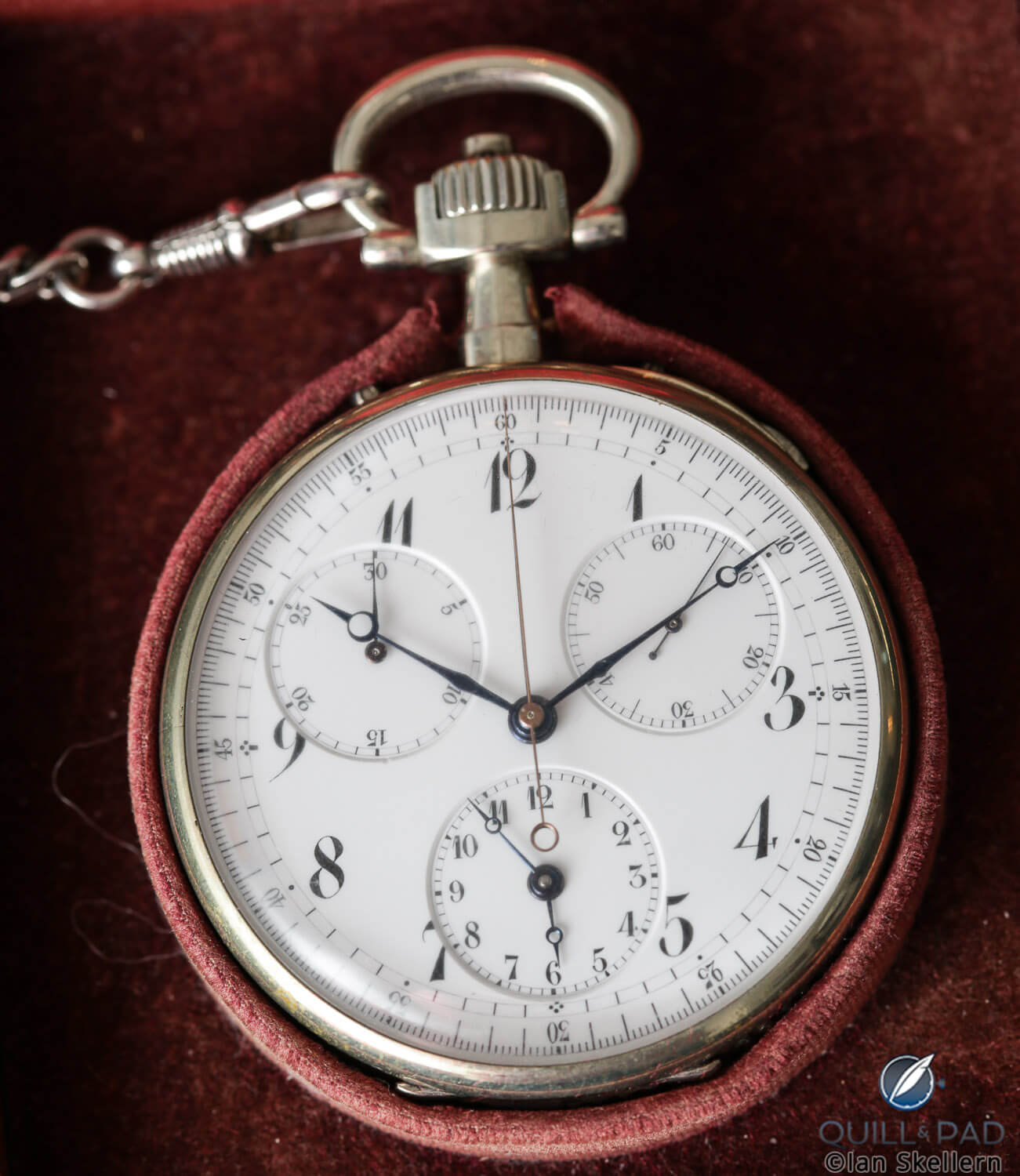
Perhaps the crown jewel of Gerd-Rüdiger Lang’s chronograph collection: a Matthias Wolfensberger unique piece
Lang answered in his earnest way when the question was put to him whether the Matthias Wolfensberger was his favorite, “It’s better than Patek Philippe,” he said, conceding that his fascination with this quasi-unknown watchmaker could also originate in the fact that – like him – Wolfensberger was a German watchmaker who had moved to Switzerland to make a living.
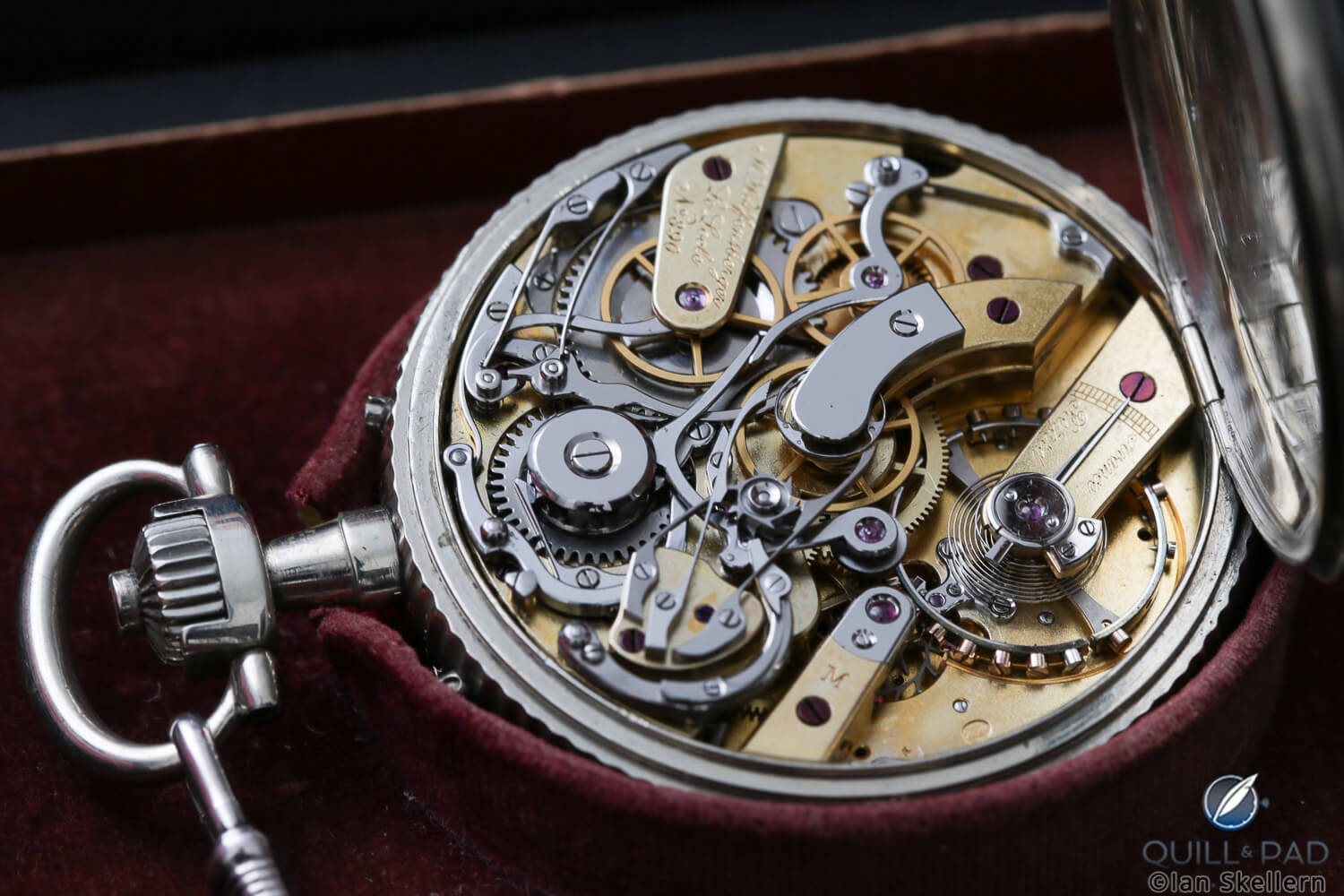
Movement of the Matthias Wolfensberger unique piece chronograph from Gerd-Rüdiger Lang’s chronograph collection
“Wolfensberger did not invent the watch, but this one is so beautiful because there is no better quality to match what is inside here,” Lang continued. “He did not cut corners with material, which is easy to see by taking the palladium hairspring as an example. A hairspring in palladium never existed anywhere else – or if it did, it was very, very rare. And that was a choice made by a watchmaker, not a salesperson.”
Quick Facts Matthias Wolfensberger unique piece pocket watch
Case: 56 mm, German silver
Movement: manual winding with palladium hairspring, chronometer certificate from Besançon Observatory
Functions: hours, minutes, running seconds; split-seconds chronograph with separate minute counter, second time zone
Production decade: 1890
Another somewhat unusual element to this collection is that there is only one Rolex model in the entire bunch, but a rather rare Reference 3834 housed in stainless steel and outfitted with a salmon-colored dial.
As Martin Green explained in Serving Up Salmon: Watches With Sublime Salmon-Colored Dials And Why They Remain Rare, finding a vintage Rolex with a salmon dial is not an everyday occurrence. Backing that statement up is the fact that Christie’s auctioned a Reference 3834 in 2013 for 35,000 Swiss francs.
Two years later, Christie’s auctioned a similar model in a slightly larger 36 mm case and powered by a Valjoux 22 movement instead of a Valjoux 69 for 162,500 Swiss francs.
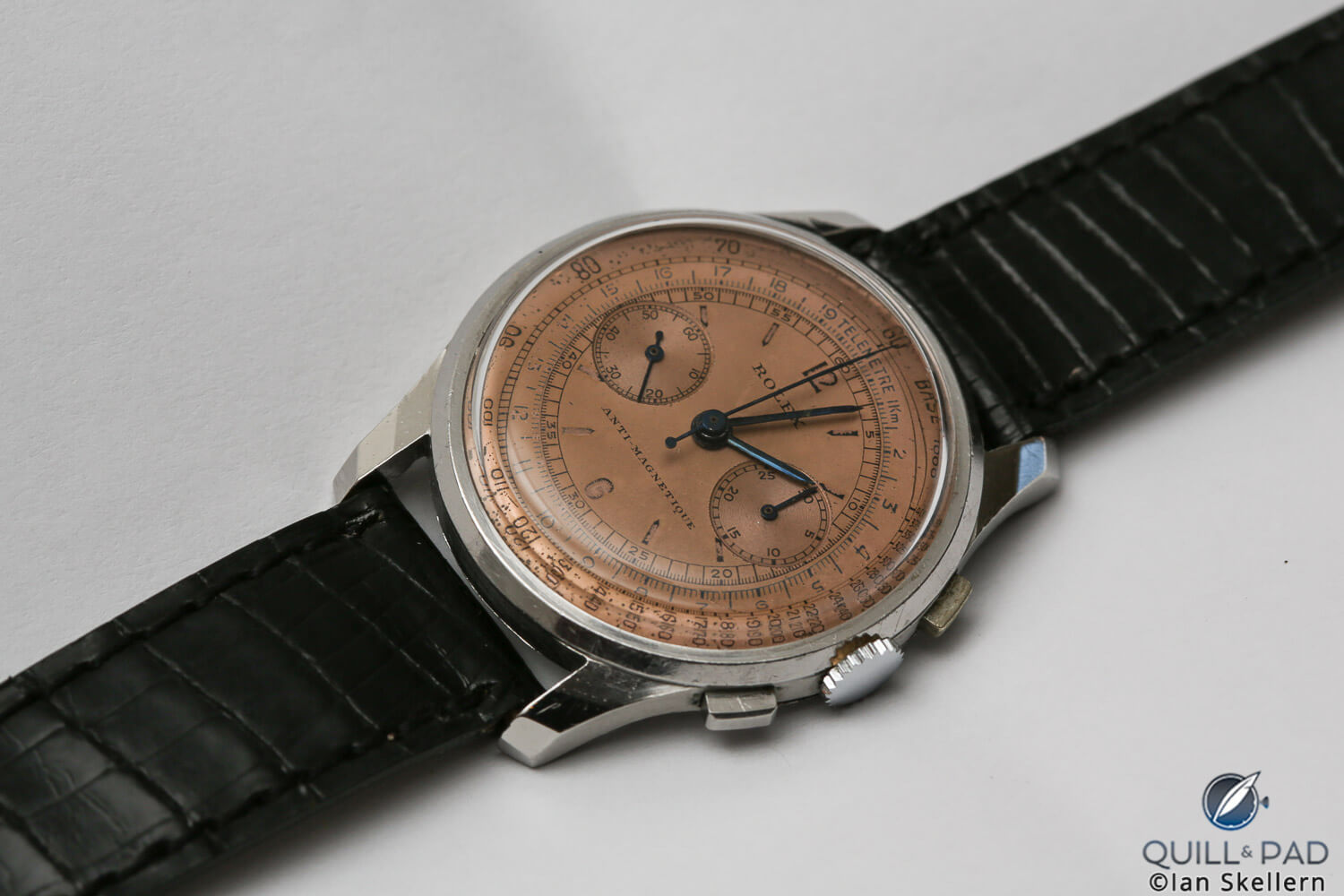
Rolex Reference 3834 from Gerd-Rüdiger Lang’s extensive chronograph collection
Lang has said time and again that he has not based any of the acquisitions in his collection on visual aspects, but rather the technical ones, so it’s my educated guess that he bought this one because no other watch in the collection had yet contained a Valjoux 69 movement.
Quick Facts Rolex Reference 3834
Case: 32 mm, steel
Movement: manual-winding Caliber Valjoux 69
Functions: hours, minutes, running seconds; split-seconds chronograph with separate minute counter
Production decade: 1940
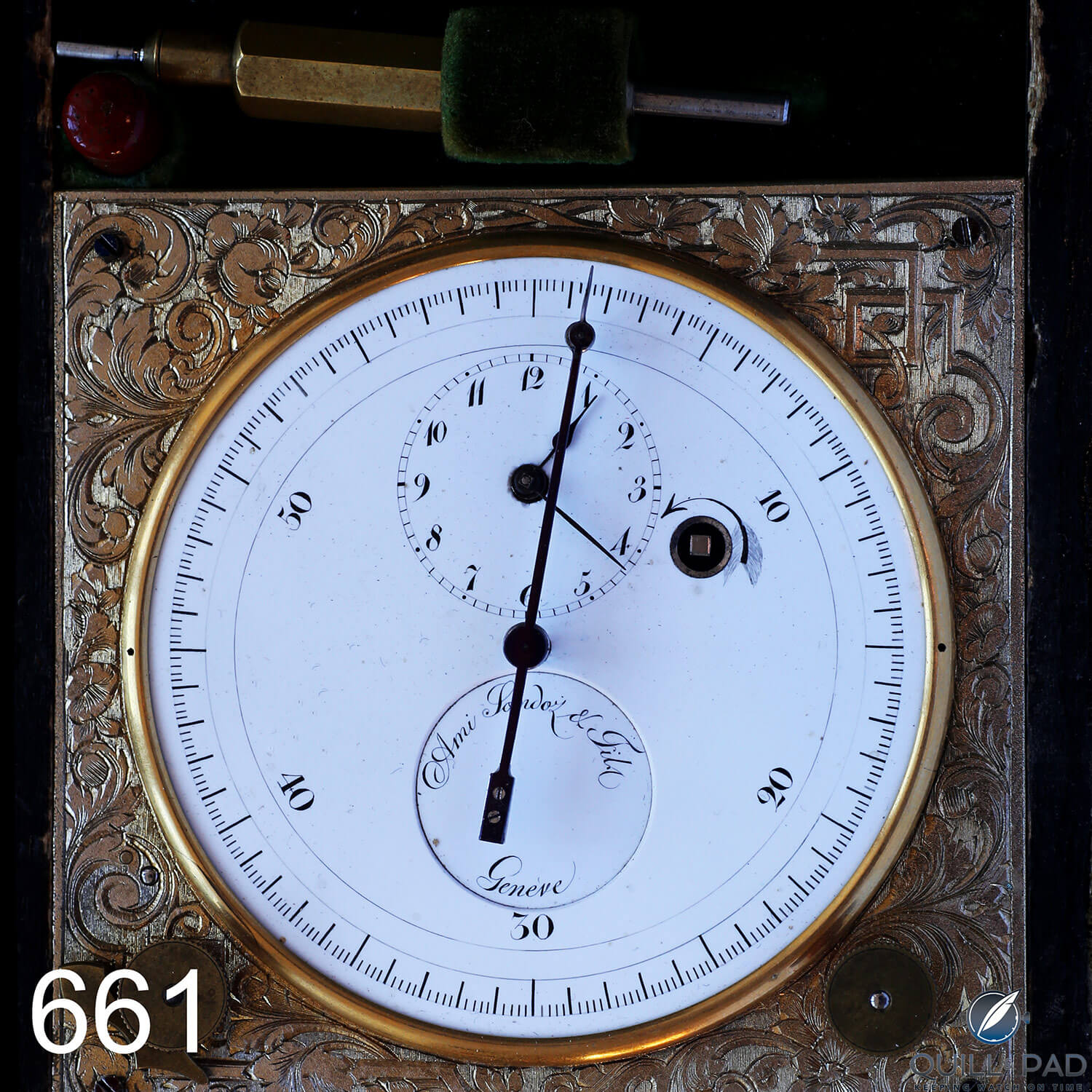
The Ami Sandoz ink-drop chronograph from Gerd-Rüdiger Lang’s extensive chronograph collection (photo courtesy Kurt Strehlow)
Another of the more amazing watches in this collection is an original ink-drop chronograph from about 1830. Made by Ami Sandoz & Fils – a Swiss company that existed from about 1820 to 1900 – it is wound by key. One like this sold in 2003 at Christie’s for 14,340 Swiss francs.
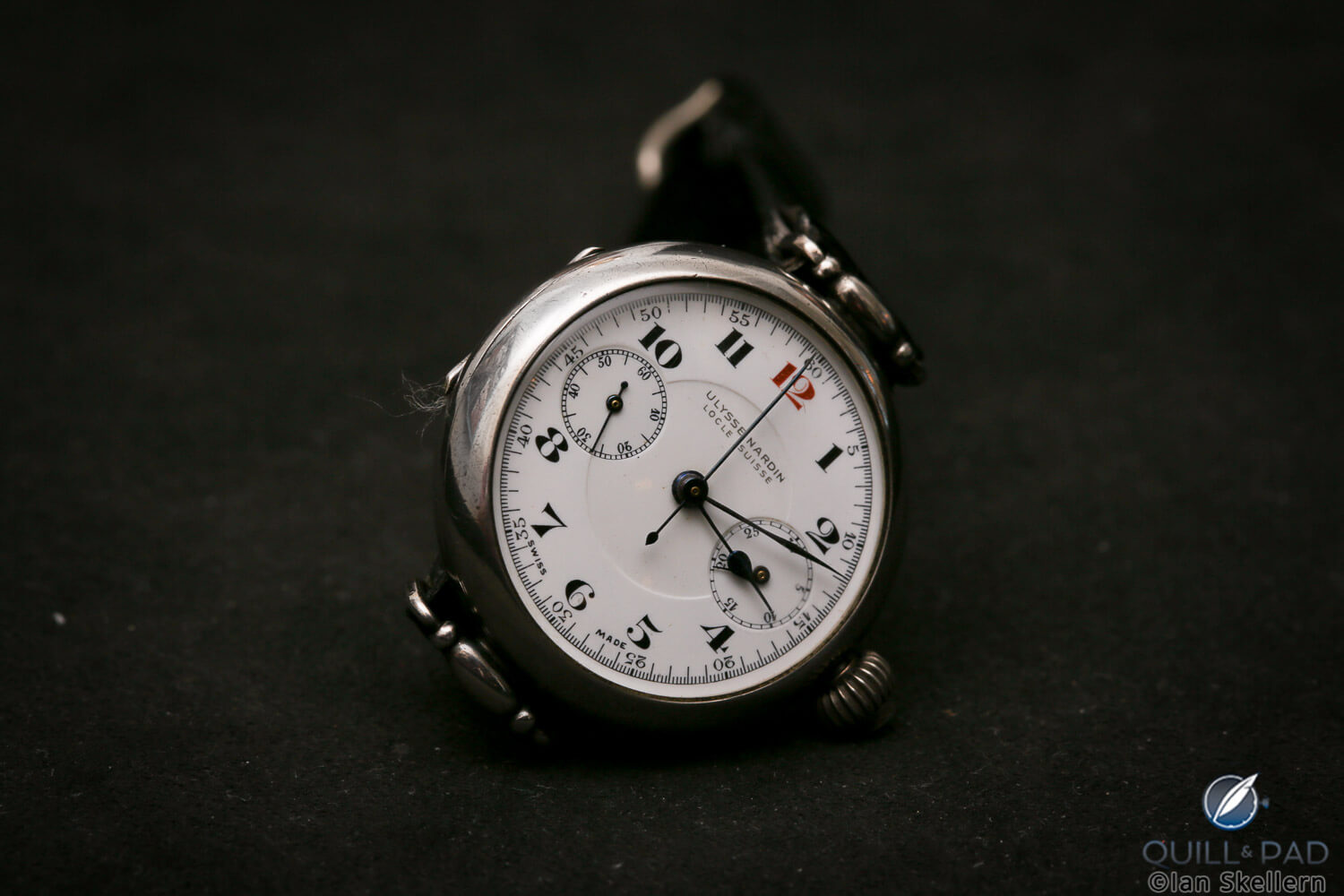
An early Ulysse Nardin chronograph with enamel dial from Gerd-Rüdiger Lang’s chronograph collection
There are also many chronographs by Ulysse Nardin in the collection, but one encased in silver from about 1920 caught our eye because of its lovely enamel dial – an element that Ulysse Nardin has carried on to this day (see Why Do Ulysse Nardin’s Dials Look So Good? Because Donzé Cadrans Authentically Fires Enamel) – as well as its unusual lugs and case back, which opens up just like a pocket watch.
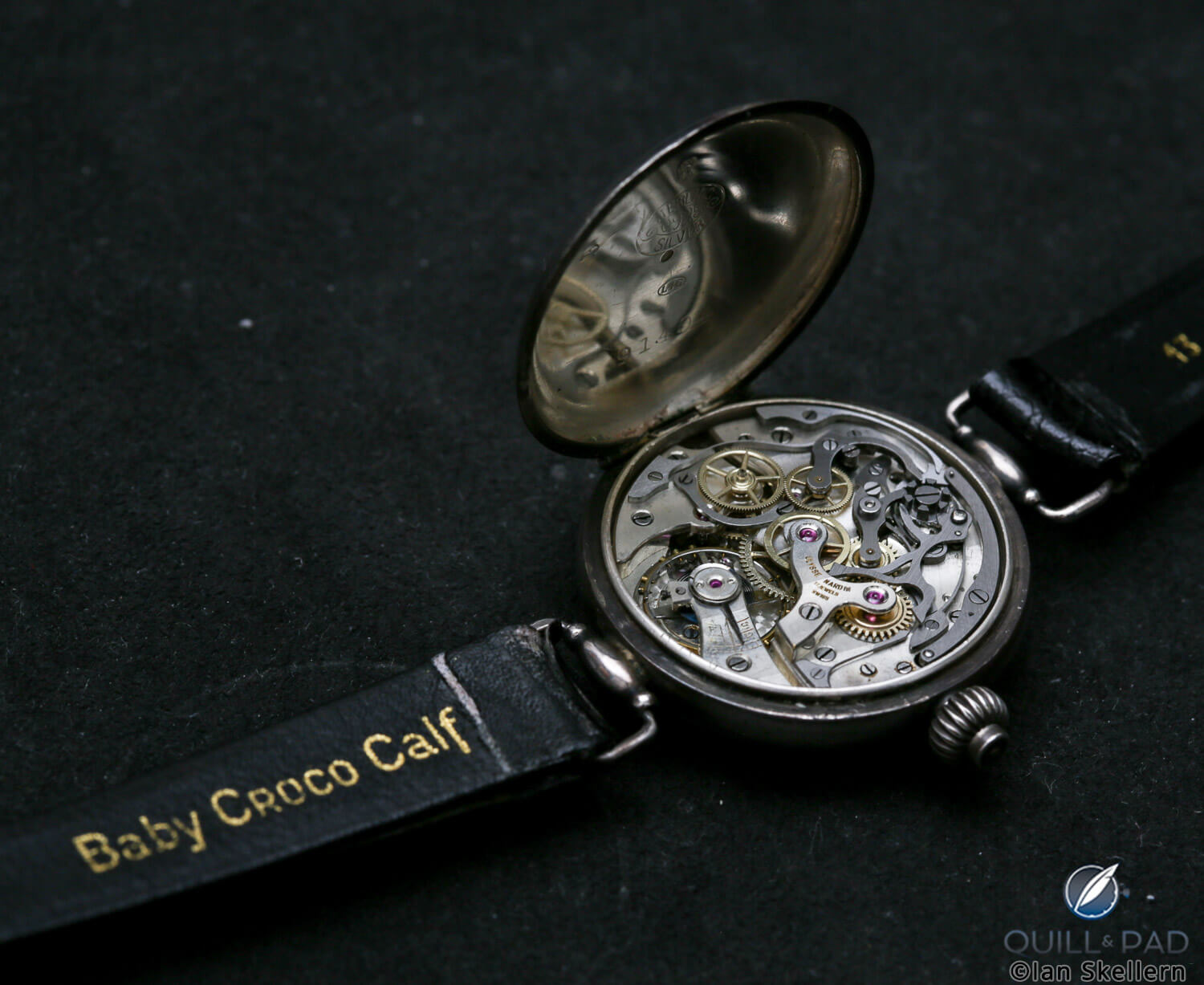
Movement side of an early Ulysse Nardin chronograph with enamel dial from Gerd-Rüdiger Lang’s chronograph collection
Additionally, it is a monopusher chronograph with one button in the crown.
Quick Facts Ulysse Nardin Monopusher Chrongraph
Case: 34 mm, silver
Movement: manual winding Caliber Valjoux 13
Dial: enamel
Functions: hours, minutes, running seconds; monopusher chronograph with separate minute counter
Production decade: 1920
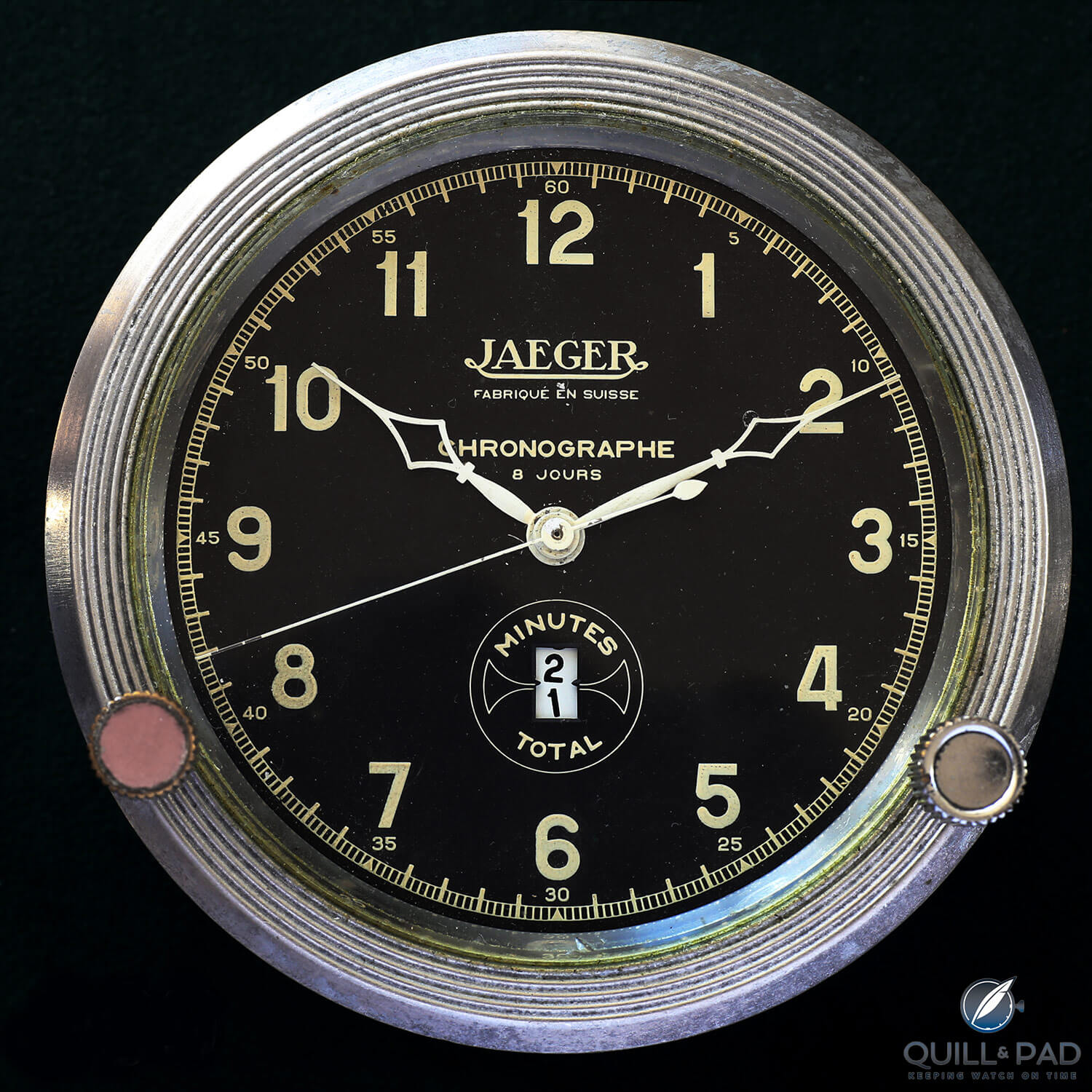
Another highlight from Gerd-Rüdiger Lang’s chronograph collection: a Jaeger dashboard chronograph probably from a Bugatti (photo courtesy Christie’s)
Another of the collection highlights is undoubtedly a dashboard instrument made by Jaeger. A little known fact is that in the 1920s, thanks to World War I, LeCoultre & Cie in cooperation with Edmond Jaeger began manufacturing counters and dashboard instruments for the most prestigious automobiles of the time.
These included Aston Martin automobiles (a great reason for the manufacture to begin the Amvox line in 2004), but also Bugatti. The instruments were simply signed “Jaeger.”
Lang’s Jaeger dashboard chronograph with an extremely rare digital minute totalizer was very likely one of those made for Bugatti. And Lang thinks this one might have been a prototype. “This is the type of watch in which you find real history,” he said.
Quick Facts Jaeger dashboard chronograph
Case: 92 mm, white metal
Movement: manual winding, eight-day power reserve
Functions: hours, minutes, seconds; digital minute counter
Production decade: 1930
Aside from a variety of Heuer models – no surprise there – and pretty much every big brand name with an important chronograph somewhere in its history, including Patek Philippe, Lang’s collection includes a number of very early Chronoswiss models in the collection, including two 1980s pieces that Lang originally made as “Rochat” models and one from 1978 in a 37 mm gold-plated case powered by a very simply finished Valjoux 7734.
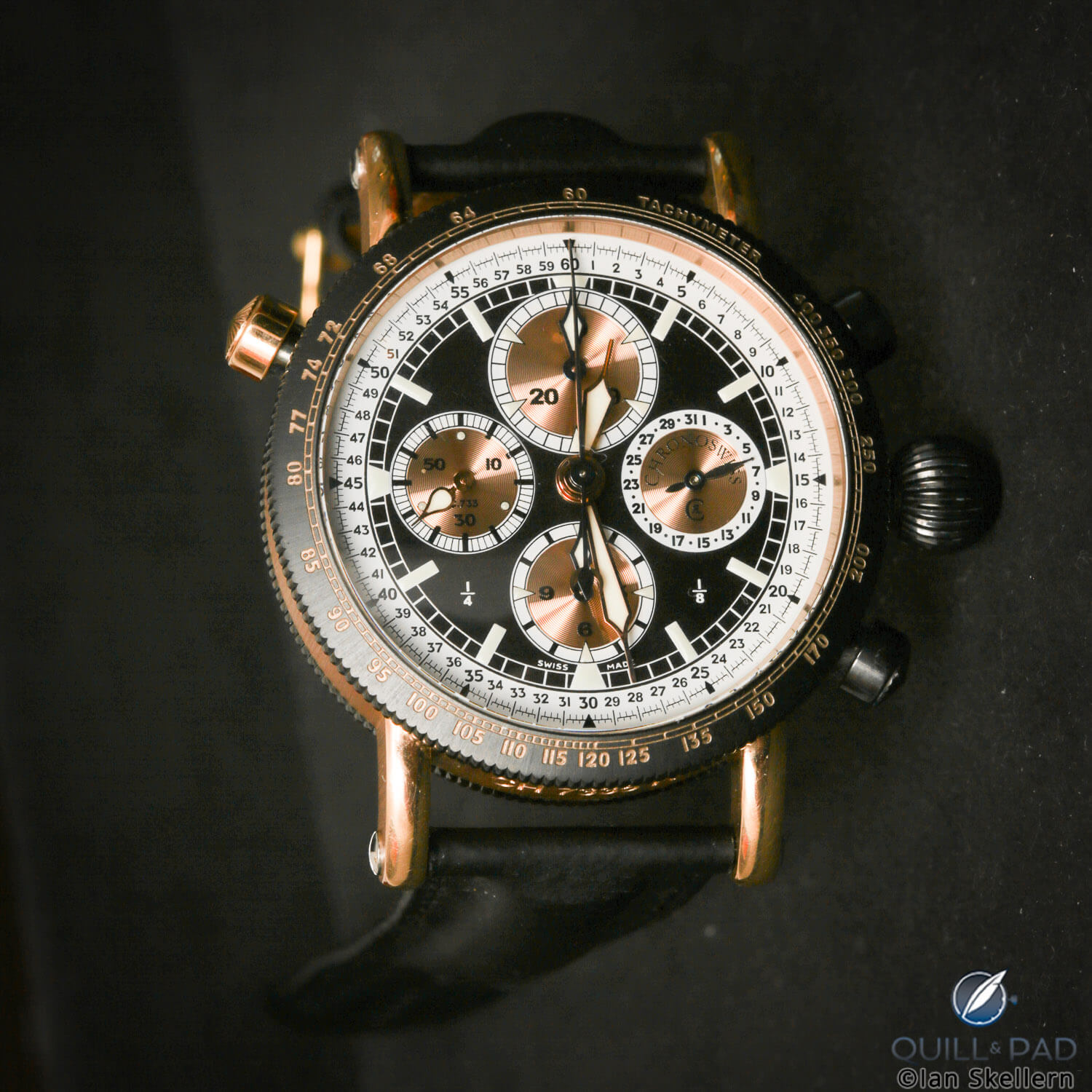
An early “Lang-system” Chronoswiss split-seconds chronograph from Gerd-Rüdiger Lang’s collection
Additionally, the collection contains a Chronoswiss pocket watch (I didn’t even know he ever made a pocket watches!), a skeletonized Valjoux-powered Kairos model in yellow gold, and a very unusual steel-encased chronograph with a red dial in addition to an unknown-to-me black-and-red “Lang-system Chronoswiss” split-seconds chronograph.
One of Lang’s claims to fame was making the first serial wristwatch with a regulator display. “That was my very beginning [as an independent brand],” the Chronoswiss founder who is sometimes known by the half-joking name “Mr. Chronograph,” reminded me.
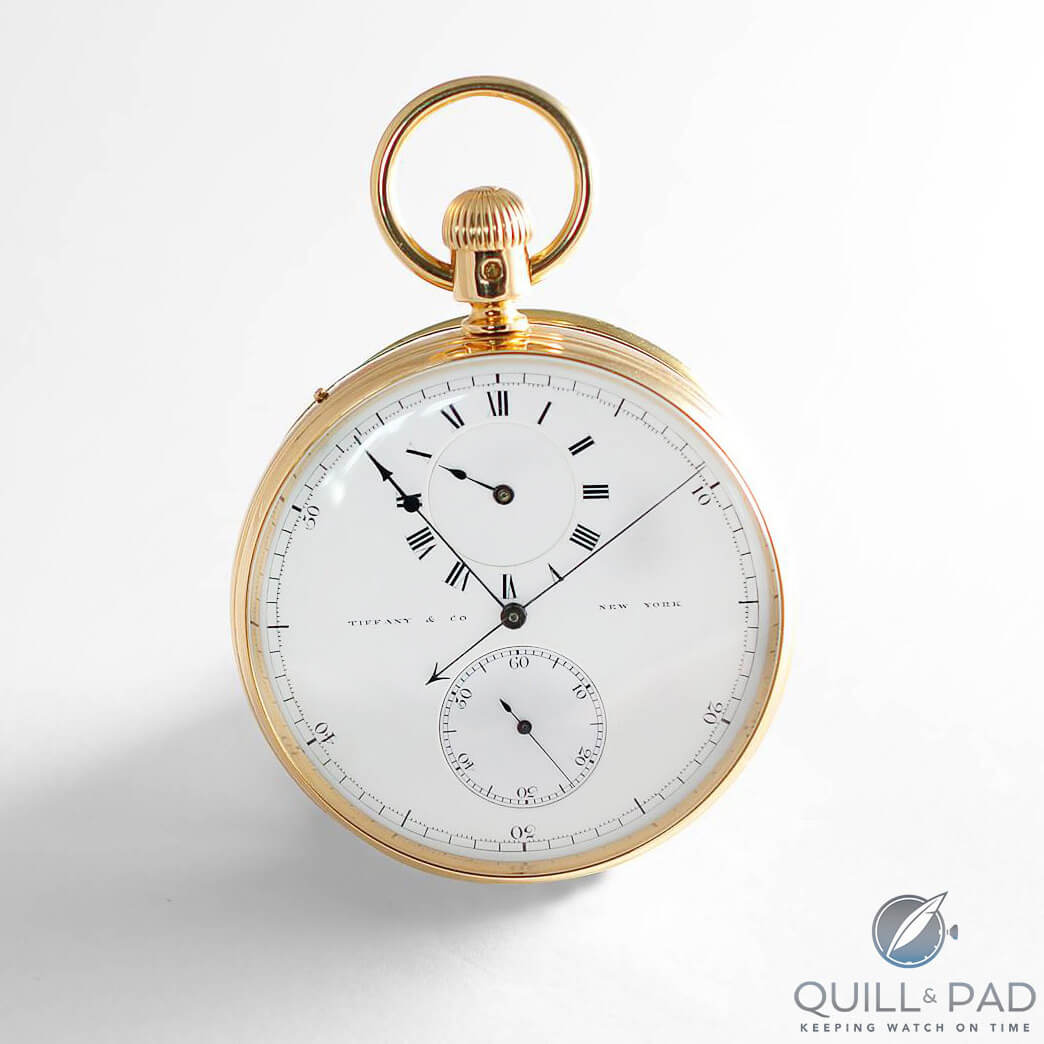
Tiffany regulator circa 1870 from Gerd-Rüdiger Lang’s collection (photo courtesy Kurt Strehlow)
The Régulaeteur model, even though it was not a chronograph, was a great success for the fledgling Chronoswiss, practically establishing it in one fell swoop. And it was inspired by this Tiffany pocket watch and others like it Lang found in the history of horology.
Gerd-Rüdiger Lang is currently considering options for the future of his collection.
Quick Facts Tiffany New York pocket watch regulateur
Case: 49 mm, 18-karat yellow gold
Movement: manual winding English movement
Functions: hours, minutes, running seconds; chronograph with sweep second counter
Production decade: 1870
You might also enjoy:
The Real Story Behind Steve McQueen’s Heuer Monaco: Exclusive Interview With ‘Le Mans’ Property Master Don Nunley
Discovery, Firsts, And The Louis Moinet Compteur De Tierces
Urwerk And The Gustave Sandoz Clock That Doesn’t Tell Time
Why The A. Lange & Söhne Tourbillon Pour Le Mérite Is One Of The Most Historically Important Modern Wristwatches
Leave a Reply
Want to join the discussion?Feel free to contribute!



Thanks for this, Elizabeth. Gerd-Rüdiger Lang is one of the stalwarts of the renaissance of the mechanical watch and his story is well worth recording. A visit to his new building was a remarkable experience. It’s sad that it’s gone.
Thank you for taking the time to read this, Timothy! And, yes, it is very sad that the Munich factory is gone.
Muchas gracias por la información histórica del Sr. Gerd-Rüdiger Lang. Tengo un reloj Rüdiger Chemnitz R 2000-04. Estoy muy contento con mi reloj alemán. Fuerte, preciso, sobrio, masculino. Saludos, desde Guatemala.
Great article but I cannot agree with a lot of the arguments/bragging from Lang.
1, “Chronoswiss is the first to develop see through caseback.” Sorry, a lot of pocket watches from 1920 already have them installed.
2, “Palladium hairspring never existed before”. Again, this is untrue, it was used in high quality English pocket watches.
3, “It is better than Patek”. Excuse me? This is just lame salesman’s attitude, which he despises earlier in the following sentences.
It is interesting to hear from a strong opinionated person but he needs to have facts backing him.